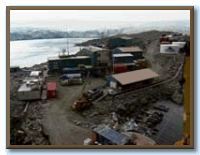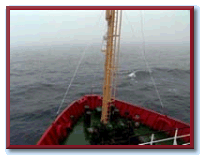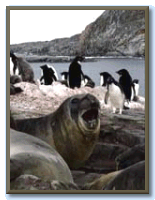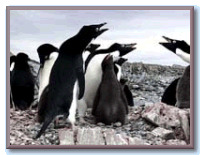|
From: Polly Penhale, Palmer Station
Letter written to Susan Cowles' "Life and Development" adult education class at Linn-Benton Community College in Albany, Oregon, by Polly Penhale, National Science Foundation Representative, Palmer Station
|
|
|
"Aerial" of Palmer Station from Polar Duke crow's nest.
|
Greetings from Palmer Station, Antarctica! I'm Polly Penhale, and responsible for Palmer Station, a small marine biology laboratory in the Antarctic Peninsula region of the continent. I'll be here about a month, while away from my job as a scientific administrator at the National Science Foundation in Washington, DC.
Palmer Station is the smallest of the three US research stations in Antarctica. Our job is to study the land and sea ecosystem here. There are 43 people on site; due to the small size of the station, this is the most we can have at one time. Half are involved in scientific projects and half are involved in operating the station. We have to be very self-sufficient to live down here.
I began my journey here in Washington, DC on January 2. I flew to Miami, Florida and then to Santiago, the capital of Chile. From there, I flew to the southernmost town in Chile, Punta Arenas. This is one of the windiest cities in the world and while I was there, it lived up to its reputation! I had my first taste of this as the Lan Chile flight made its long, low arc over the ocean to approach the airport. The airplane was vibrating violently and the pilot announced winds gusting to 90 knots. Luckily, the pilot was skilled enough to land the plane!
From Punta Arenas, I boarded the US oceanographic research ship, the Polar Duke. We spent four days at sea en route to Palmer Station. Our departure from Punta Arenas was delayed a half day due to the intense winds which blew the ship right against the pier. The pier itself was closed part of the day due to 60-70 knot winds. During my walk in town, the gusts were ferocious and at one point I had to hold onto a street sign to avoid being blown to the ground.
|
|
|
Bow of Polar Duke while crossing the Drake Passage.
|
The first two days of the voyage were rough, with a good pitch and roll, and I spent most of my time seasick and flat in bed. Luckily, the seas calmed and I recovered for the last two days of the voyage. We stopped en route to repair an automatic weather station on a tiny island about four hours from the station. I finally arrived at Palmer Station on January 8, nearly a week after I left home.
|
|
|
Elephant seal letting his prescence be known, Humble Island.
|
Palmer Station is a small community. We have two main buildings and a number of smaller buildings and storage structures. The station sits on a spit of land surrounded by water on three sides and a huge glacier just behind the station. Ten little islands are located within a two mile radius; these islands are filled with seals, penguins and other seabirds. Everywhere you look are islands, glaciers, and the ocean. It's a beautiful and peaceful place.
We live crowded together in our small community. The main building is called the Biolab. The ground floor has the scientific laboratories, the machine shop, and the doctor's office. The second floor houses the communications center (computers for e-mail and the communication radio), the lab stockroom, some offices, the kitchen and dining room, and the food storage. The third floor houses half the station personnel. Two people share a room with bunk beds. There is one bathroom for men and one for women. It's pretty crowded, as ten women share the bathroom which has one sink, one toilet and one shower!
The second main building is called GWR, which stands for Garage, Warehouse and Recreation. The ground floor houses the power plant, the maintenance garage and various storerooms. The second floor houses offices, a tiny gym, more berthing and a lounge with TV, dart board and pool table. We are too isolated to actually receive TV, so we watch videos for recreation. We keep in contact with friends and family via e-mail and ham patch radio. The telephone is only used for emergencies because it costs $10 per minute.
All of our supplies -- fuel, food, building materials, laboratory equipment and supplies, etc. -- arrive by ship, which comes about every four to six weeks. We learn to conserve, because if we use something up, we just live without. Perhaps life sounds pretty spartan here, but the trade-offs are worth it. The area is an excellent place for research so the scientists and students are content. The people who run the station -- the station manager, facilities engineer, electrical, inventory/cargo people, the power plant mechanic, the boating coordinator, the cooks -- are doing a job in a beautiful surrounding. Once you have been to Antarctica, the sheer beauty and power of the environment keeps you coming back.
|
|
|
Animated Adelies with chick in foreground, Humble Island.
|
I'm writing this letter to you on Sunday evening. It's our one day off each week. It's also the cooks' day off, so breakfast and dinner are pot-luck out of the refrigerator and volunteers cook dinner. The scientists worked just like any other day. The group studying penguin behavior left in the morning for a small island nearby, which has 8,000 Adelie penguin pairs nesting there. We travel between islands in a zodiac, which is a small inflatable boat. I went along for a few hours to help. We counted the adults and chicks in order to learn about population growth. Since it's summer here, the snow is gone and the birds are easy to study on their nests made of little pebbles.
One of the other science groups stayed on station to analyze the data on plant growth that they collected during the previous week. They mainly study the one grassy plant in Antarctica (ed. note: see Tad Day's work, to be featured in Program 3, and Activity 3.2 in the Teacher's Guide.)
Other people on station just relaxed, wrote e-mails, played computer games, read and watched videos. I came back from the field early, as I had volunteered to cook dinner for everyone. I'm not used to cooking for 43 people, so it was quite a challenge! We have lots of ingredients and I'm adventurous, so I decided to make Indian food. I made chicken tikka, dal (curried lentils), raita (chopped cucumbers in plain yogurt), saffron rice and served mango chutney on the side. I gave up on dessert, so those with a sweet tooth just had to fend for themselves. No matter what's for Sunday dinner, people appreciate someone else cooking.
Tomorrow we start the work week again. It's not a typical place to live and work, but I wouldn't want to be anywhere else.
|
![]()



